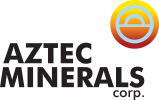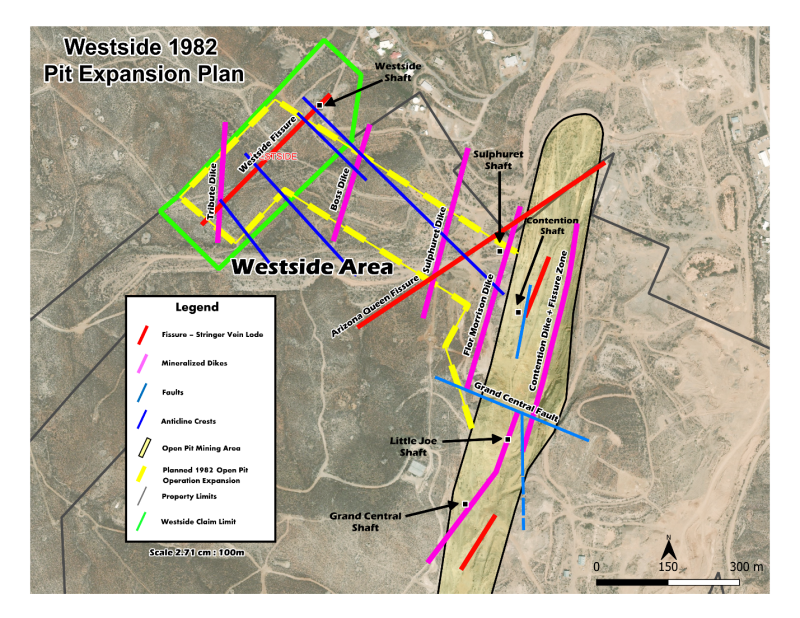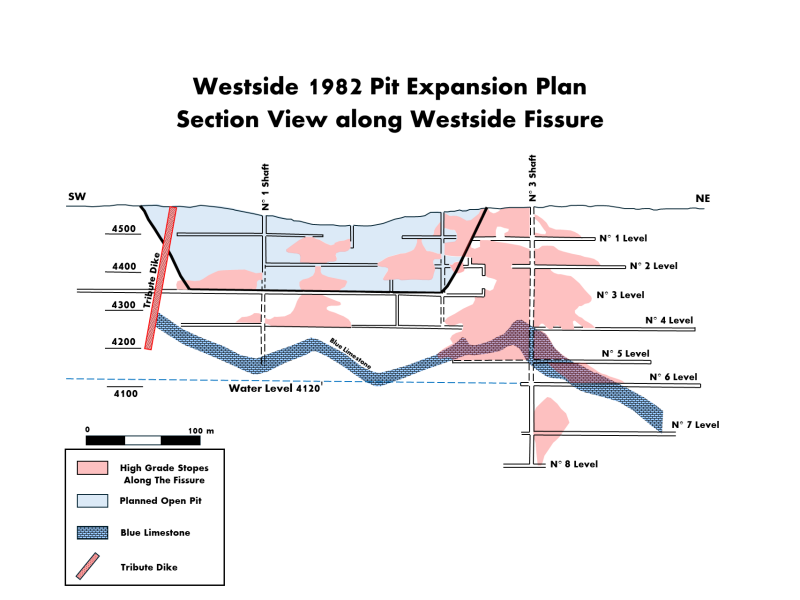(TheNewswire)
 | |||||||||
-
Westside Area of Tombstone project identified as high potential shallow gold-silver expansion target.
-
Crew have mobilized and commenced 2024 exploration program at Tomsbtone project.
News Release - Vancouver, Canada – TheNewswire - April 22, 2024 - Aztec Minerals Corp. (AZT: TSX-V, OTCQB: AZZTF) (“Aztec” or the “Company”) announces that recent field work and review of historical data at the Tombstone Project has identified the Westside area (see Figure 1 below) as a high potential target for shallow gold-silver mineralization, almost doubling the project’s potential gold-silver oxide mineralization footprint near to the historic Contention Pit.
In 2023, the Tombstone JV acquired the Westside patented claim (see new release dated May 2, 2023) which is longitudinally astride the major Westside fissure stringer vein lode, a key geological feature with multiple evidence of hosting high-grade gold silver oxide mineralization in the Tombstone Project. Recent review of historic data and on-site investigations by Aztec have confirmed that the Westside area was previously planned as an expansion of the Contention pit operations at the time on the interruption of mine operations in 1982.
Aztec’s recent exploratory work has confirmed several mineralized structures crossing the Westside area. From the study of historic reports, maps and sections, examination of historic workings and drillhole logs, the individual mineralized structures are strong targets, with indicative evidence of their intersections potentially hosting broad gold-silver mineralization at levels near the surface.
Figure 1- Tombstone Property – Westside Area and 1982 Planned Pit Expansion for Gold-Silver Oxide Shallow Mineralization
A review of historical data has confirmed that the Westside anticline was mined along multiple, replaced sediment layers near the axis to its crest in the sediments over all its 450+ m length, noting that, at its intersection with the Arizona Queen Fissure, the 120 m long Sulphuret stope, was mapped at over 60 m wide and 10-20 m thick. The Sulphuret stope was reported (Butler, 1938) to have production averaging 70 opt silver and high-grade gold as well. Aztec’s drilling has confirmed that the gold-silver mineralization in the property extends beyond the limits of the historic mined stopes.
Most of the Westside area and its multiple targets have yet to be explored. The Westside -Sulphuret mine workings reached to the 7th and 8th levels (210-250 m), and historic drilling has significant CRD intercepts at 500 to 600 m depths.
The 1982 historic mine development plan (see Figure 2 below) shows that the full width and depth of the shallow gold-silver mineralization was not included in the mine planning. It is thought that the Blue limestone layer and the sediments immediately above and below it, also shown in Figure 2, would have the best potential to host oxidized gold-silver mineralization Tombstone was famous for, as it is the same sediment section of the lowest Bisbee formation. The Westside area open pit mine was not developed possibly as the timing for halting mining is coincident with the collapse of silver and gold prices in the early 1980’s.
Figure 2. Westside 1982 Pit Expansion Plan Section View
Current Exploration Program
Aztec also announces that crews have mobilized to site and have commenced the 2024 Tombstone exploration program (see news release dated April 17, 2024). Company is currently developing drill targets with multiple disciplines including the continuation of the surface exploration program in the area of the Contention pit and surroundings, advancing the detailed geological mapping, and further out with reconnaissance level geological mapping of lithologies, Terraspec alterations and structures, multi-element rock geochemistry, and thin section petrology and alterations to review the hosting of the gold-silver mineralization. The data acquired will then be integrated into the 3D model being constructed including the historic mine workings and geologic mapping of the principal portion of the Tombstone district. The 3D model is being geolocated to the current surface and geology, geochemistry and geophysics and will then be interpreted to strengthen both shallow and deep drilling targeting. This will be used in supporting the upcoming drilling program design
The ongoing exploration program is expected to add knowledge into the expansion potential of the bulk tonnage, gold-silver oxidized mineralization, and from that, continue drilling and mineralization footprint. The focus of this exploration program is to better define the three styles of mineralization known to exist on the property and to identify top priority targets for drilling. The three types of known mineralization at the Tombstone property are as follows:
-
Silver-gold bearing, north-northeast striking felsic intrusive dikes hosting mesothermal stock-works and hydrothermal breccias that cut the Cretaceous Bisbee Group and the underlying Paleozoic carbonates, on which the historic Contention underground mine and later the 1980’s open pit heap leach mine was developed, which now is known to extend laterally and vertically beyond the Contention pit
-
High-grade, silver-gold quartz stringer vein lodes striking northeast cutting the Cretaceous Bisbee Group clastic sediments and the Paleozoics, which are related to several of the historic mines in the Tombstone district
-
Tombstone’s well known, high grade, oxidized, silver-gold rich base metal carbonate replacement deposits (“CRD”), which lie in the lowermost Bisbee Group and in the underlying Paleozoic carbonates, have a geologic setting very similar to the world-class Hermosa Taylor base metal sulfide deposit of South32, located 65 kilometers southwest of Tombstone. Strong structural controls of the Tombstone CRD deposit locations related parallel to the crests of anticlines, usually with vertical (“reef”) stacking on multiple, favorable horizons
Positive indications for mineralization at Tombstone include:
-
The Bisbee sediments exhibit widespread fracturing, silica-pyrites-sericite-clay alteration, quartz veinlets, stockworks, and hornfelsing and in the limestones jasperoids, dolomitization and skarn development
-
The Contention open pit mine is centered along a strong NNE fault structure with large, mineralized felsic dikes possibly related to a deeper intrusion
-
The underground Contention mine mined the dike mineralization to over 300 m depth
-
Historic drilling by Newmont and Santa Fe to over 700 m depth have intersected narrow to wide, high grade CRD mantos, evidence that the Paleozoic limestones are prospective
-
The presence of several manganese-silver rich mines surround the Property are considered indicative of distal mineralization to CRD deposits worldwide
Tombstone Project Overview
Aztec holds a 75% interest in the Tombstone Property Joint Venture, which includes most of the original patented mining claims in the main district as well as some recently acquired properties.
The main target of the 2023 core drill program was to continue testing the shallow, bulk tonnage, heap leachable, mesothermal gold-silver oxide mineralization adjacent and below the previously mined Contention pit by infill and step-out drilling. Core drilling was deemed needed in order to penetrate the multiple historic workings and to acquire needed geological data. Future drilling is expected to focus on strike and dip extensions of the shallow oxide mineralization, and move deeper to test for larger, deeper “Taylor-type” CRD targets along and adjacent to the Contention structure.
The Tombstone project is located 100 kilometers (km) southeast of Tucson, Arizona and covers much of the historic Tombstone silver district. Tombstone is renowned for its high grade, oxidized, silver-gold mesothermal stringer lode veins, hydrothermal breccias and manto CRD orebodies that were mined in the late 1800’s and early 1900’s. The historic silver production in the Tombstone district from 1878 to 1939 was estimated at 32 million ounces and 250,000 ounces of gold.
The district geology consists of a complicated mix of shallow-level, oxidized Au-Ag and base metal deposits related to CRD and skarns hosted in folded and thrusted sediments, intrusive dikes and lode veins, and as well the under explored, sulfide versions located below the water table.
Host rocks to the mineralization are primarily the clastic sediments of the lowest portion of the Cretaceous Bisbee Formation. Between 50 and 300 meters (m) in depth, the Bisbee is underlain by approximately two kms thick of the same Paleozoic carbonate formations that host the 110 MT Hermosa-Taylor zinc-lead-silver deposit of South32 located 60 km southwest of Tombstone.
Although the historic silver mines at Tombstone were generally small, Aztec believes they could be related to much larger mesothermal and CRD orebodies below the old mines. Since 2017, Aztec has completed geological mapping, geochemical sampling and geophysical surveying to identify the most prospective areas for Au-Ag mineralization around and below the Contention open pit, and CRD zinc-lead-copper-silver-gold mineralization below the entire district. Aztec management views the district as highly prospective for the discovery of mesothermal and CRD orebodies.
Note: Gold equivalents are calculated using a 80:1 silver:gold ratio in 2020 and 2023 and a 70:1 silver:gold ratio in 2021. Reported lengths are apparent widths, not true widths. The Contention Au-Ag mineralization zones are generally west dipping at around 60-80 degrees, associated with the quartz-feldspar porphyry dikes. However, these dikes also extend as sills in shallow angles out from the Contention fault along fold noses in the Bisbee clastic sediments so the full range of mineralization dips vary from 20 to 80 degrees. True widths for the apparent mineralization intersection widths of the drill holes approximately range from 50 to 100% of the apparent widths, with the norm for the mineralized true widths being 60 to 90% of the apparent widths. Please see summary news releases dated: July 5, 2023, December 7, 2021, and January 12, 2021.
*Grade-Thickness in meters-grams/tonne means the result of multiplying a drill hole intercept length, measured in meters, by the grade of the gold values in the intercept, the resulting compiled number is measured in grams/tonne. Grade thickness is not to be construed as gross metal value nor as a resource. The Tombstone property does not have a current, compliant resource estimation at this point.
Summary Tombstone Project Highlights
-
Well located property on patented (33) and unpatented (42) claims (452.02 hectares/1,116.94 acres), covers much of the historic Tombstone silver mining district, great infrastructure, local town, road access, full services, water, power
-
Historic silver district produced 32 million oz silver from 1878-1939, in high grade, oxidized, silver-gold-lead-zinc-copper vein, breccia and CRD deposits, and small open pit heap leach production in late 1980’s
-
Drilling by Aztec in 2020-23 has demonstrated that the Contention Pit target has significant, shallow. oxidized Au-Ag bulk tonnage mineralization which is open in all directions
-
Multiple other prospective targets in Cretaceous and Paleozoic rocks related to major NW and NNE trending structures hosting porphyritic intrusions crosscutting a possible caldera ring structure
The following are highlights of recent drilling intersections supporting the conceptual exploration model for mineralized footprint growth.
-
TR21-22: 2.44 gpt Au and 66.56 gpt Ag (3.39 gpt AuEq)over 65.5m (including 16.80 gpt Au and 374.36 gpt Ag over 7.6m)
-
TR21-03 - 5.71 gpt Au and 40.54 gpt Ag (6.28 gpt AuEq) over 32.0m
-
TC 23-01: 3,477 gpt Ag over 1.52m from a zone of 733.9 gpt Ag over 7.6 m within 125 m of 1.63 gpt AuEq
-
TR21-10: 1.39 gpt Au and 56.40 gpt Ag (2.20 gpt AuEq) over 96.0m
-
TR21-13: 1.8 gpt Au and 36.9 gpt Ag (2.33 gpt AuEq) over 70.1 m
-
TR21-17: 1.73 gpt Au and 56.20 gpt Ag (2.53 gpt AuEq) over 64.0m
-
TR21-08: 2.09 gpt Au and 47.1 gpt Ag (2.76 gpt AuEq) over 39.6m
-
Hole TC23–02 – 1.69 gpt gold and 29.07 gpt silver (2.03 gpt gold AuEq) over 45.3 m, including 10.1 m grading 6.63 gpt gold and 72.81 gpt silver (7.49 AuEq)
-
TC23-05 – 2.816 gpt gold and 176.64 gpt silver (5.02 gpt AuEq) over 36.0 m, including 6.45 gpt gold and 408.47 gpt silver (11.554 gpt AuEq) over 15.5 m
The company in conjunction with its exploration sampling programs uses quality assurance-quality control as part of its sampling-assaying-assessments. Samples and their collection are controlled by an industry standard conforming QAQC program including insertions of certified standards, blanks and sample duplicates. The samples are being regularly shipped to and received by the Bureau Veritas Minerals laboratory in Hermosillo, Mexico for geochemical analysis.
Core and RC drilling samples are continuously collected over 5 foot (1.52m) sample intervals from all drill holes. The samples were analyzed for gold with a 30-gram sample size using the fire assay method FA430 followed by multi-element MA300, including silver. Over limits, when present, are analyzed by MA370 or FA530. All holes contain certified blanks, standards, and duplicates as part of the quality control program.
Allen David Heyl, B.Sc., CPG., VP Exploration of Aztec, is the Qualified Person under NI43-101, supervised the Tombstone exploration programs. Mr. Heyl has reviewed and approved the technical disclosures in this news release.
“Simon Dyakowski”
Simon Dyakowski, Chief Executive Officer
Aztec Minerals Corp.
About Aztec Minerals – Aztec is a mineral exploration company focused on two emerging discoveries in North America. The Cervantes project is an emerging porphyry gold-copper discovery in Sonora, Mexico. The Tombstone project is an emerging gold-silver discovery with high grade CRD silver-lead-zinc potential in southern Arizona. Aztec’s shares trade on the TSX-V stock exchange (symbol AZT) and on the OTCQB (symbol AZZTF).
Contact Information - For more information, please contact:
Simon Dyakowski, President & CEO, Director
Tel: (604) 685-9770
Fax: (604) 685-9744
Email: [email protected]
Website: www.aztecminerals.com
Neither the TSXV nor its Regulation Services Provider (as that term is defined in the policies of the TSXV) accepts responsibility for the adequacy or accuracy of this release. No stock exchange, securities commission or other regulatory authority has approved or disapproved the information contained herein.
Forward-Looking Statements:
Certain statements contained in this press release may constitute forward-looking statements under Canadian securities legislation. Generally, forward-looking information can be identified by the use of forward-looking terminology such as “expects” or “it is expected”, or variations of such words and phrases or statements that certain actions, events or results “will” occur. These forward-looking statements are subject to a number of risks and uncertainties. Actual results may differ materially from results contemplated by the forward-looking statements. Factors that could cause actual results to differ materially from those in forward-looking statements. Accordingly, the actual events may differ materially from those projected in the forward-looking statements. When relying on forward-looking statements to make decisions, investors and others should carefully consider the foregoing factors and other uncertainties and should not place undue reliance on such forward-looking statements. The Company does not undertake to update any forward-looking statements, except as may be required by applicable securities laws.
Copyright (c) 2024 TheNewswire - All rights reserved.


